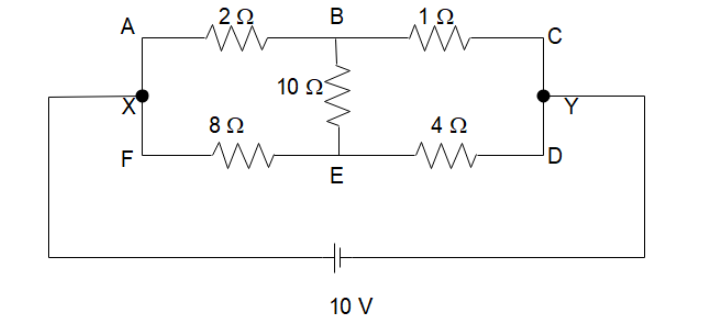
A combination of five resistors is connected to a cell of emf 10 V the potential difference

A) +5 V
B) +3 V
C) +1 V
D) Zero
Answer
141.9k+ views
Hint: In this solution, we will determine the net resistance of the circuit. Then we will find the net current in the circuit using Kirchhoff’s law and then calculate the potential difference across B and E. The centre resistance will form a Wheatstone bridge and won’t contribute to the resistance of the circuit.
Formula used: In this solution, we will use the following formula:
1- Ohm’s law:
Complete step by step answer:
IN the circuit given to us, the ratio of resistances formed by the resistors on top of each other with their side-by-side counterpart will be
Then, the current in the circuit can be found out a follows:
The
The individual net resistance of the top branch of resistors will be
Similarly, the net resistance of the bottom branch will be
These two net resistances will be in parallel i.e., the top branch and the bottom branch will be in parallel so the net resistance will be:
We can find the current in the circuit using Kirchhoff’s law as
Which gives us
This current will flow the top and the bottom branches separately and no current will flow between points B and E. So, the net potential difference across the two points according to the relationship
So, option (D) is the correct choice.
Note: The value of the potential in the branch connecting B and E is inconsequential since the conditions of a Wheatstone bridge depend on the points around the Wheatstone bridge and not on the resistor in the branch itself. So, even if the resistance of
Formula used: In this solution, we will use the following formula:
1- Ohm’s law:
Complete step by step answer:
IN the circuit given to us, the ratio of resistances formed by the resistors on top of each other with their side-by-side counterpart will be
Then, the current in the circuit can be found out a follows:
The
The individual net resistance of the top branch of resistors will be
Similarly, the net resistance of the bottom branch will be
These two net resistances will be in parallel i.e., the top branch and the bottom branch will be in parallel so the net resistance will be:
We can find the current in the circuit using Kirchhoff’s law as
Which gives us
This current will flow the top and the bottom branches separately and no current will flow between points B and E. So, the net potential difference across the two points according to the relationship
So, option (D) is the correct choice.
Note: The value of the potential in the branch connecting B and E is inconsequential since the conditions of a Wheatstone bridge depend on the points around the Wheatstone bridge and not on the resistor in the branch itself. So, even if the resistance of
Latest Vedantu courses for you
Grade 10 | MAHARASHTRABOARD | SCHOOL | English
Vedantu 10 Maharashtra Pro Lite (2025-26)
School Full course for MAHARASHTRABOARD students
₹33,300 per year
EMI starts from ₹2,775 per month
Recently Updated Pages
Uniform Acceleration - Definition, Equation, Examples, and FAQs

Difference Between Mass and Weight

Young's Double Slit Experiment Step by Step Derivation

Difference Between Circuit Switching and Packet Switching

JEE Main Participating Colleges 2024 - A Complete List of Top Colleges

JEE Main Maths Paper Pattern 2025 – Marking, Sections & Tips

Trending doubts
JEE Main 2025 Session 2: Application Form (Out), Exam Dates (Released), Eligibility, & More

JEE Main Exam Marking Scheme: Detailed Breakdown of Marks and Negative Marking

JEE Main 2025: Derivation of Equation of Trajectory in Physics

Electric Field Due to Uniformly Charged Ring for JEE Main 2025 - Formula and Derivation

Learn About Angle Of Deviation In Prism: JEE Main Physics 2025

Electric field due to uniformly charged sphere class 12 physics JEE_Main

Other Pages
JEE Advanced Marks vs Ranks 2025: Understanding Category-wise Qualifying Marks and Previous Year Cut-offs

JEE Advanced 2025: Dates, Registration, Syllabus, Eligibility Criteria and More

JEE Advanced Weightage 2025 Chapter-Wise for Physics, Maths and Chemistry

Degree of Dissociation and Its Formula With Solved Example for JEE

JEE Main 2025: Conversion of Galvanometer Into Ammeter And Voltmeter in Physics

Dual Nature of Radiation and Matter Class 12 Notes: CBSE Physics Chapter 11




